Chanterelle – Identification, Distribution, Edibility, Ecology, Sustainable Harvesting, Cooking, Processing, Recipes
Chanterelle – Cantherellus Cibarius
AKA: Sometimes referred to as “golden chanterelles” or “summer chanterelles” to further distinguish them from winter chanterelles. Pfiefferling (Germany), (Vanlig) Kantareli (Sweden), gallinaccio (Italy). Girolle (France) – note that in France the term “chanterelle” is used to refer to winter chanterelles, and many classically trained chefs often use the term “girolle” to refer to cantharellus cibarius.
In North America recent DNA analysis of what was previously classified as Cantharellus cibarius has shown to be a group of related species known as the Cantharellus cibarius group or species complex.
Related Post:
- Chanterelles – Sustainable and Considerate Harvesting
- How to pickle chanterelles (and other wild mushrooms)
- Pickled chanterelles with pineapple weed recipe
- Edibility – 4/5 – Delightful, tasty, firm textured mushrooms, with a delicate flavour, but lacking the mushroomy intensity and umami of some wild mushrooms.
- Identification – 4/5 –
- Similar Species: Possible confusion with False Chanterelle (Hygrophoropsis aurantiaca), which is more-or-less edible, and not dangerous – see below for how to tell them from chanterelles. Jack-o’-lanterns (Omphalotus illudens) are toxic but rare in the UK, confined to a few locations in SE England. They are more common in central and Southern Europe and in the US (East of the Rocky Mountains). Jack-o’lanterns grow from (often buried) decaying hardwood roots and stumps.
- Similar cantherellus species: there are at least 6 closely related and similar looking Cantherellus species in the UK. They can be hard for inexperienced foragers to distinguish from c.cibarius. All are edible, but should be picked only with restraint due to their rarity (though I suspect that some are less rare than thought, being underreported). In particular:
- Pale chanterelle (C. pallens) – distinguished by its paler cap
- C. ferruginascens – paler, with a tendency to discolour slightly rusty in patches
- Orange or velvet chanterelle (C. friesii) – cap color varies from deep yellow to reddish orange
- Amethyst chanterelle (C. amethysteus) – Orange caps with an amethyst coloured ‘bloom’, becoming hard to distinguish as the mushroom matures
- Blackening chanterelle (Cantherellus or Craterellus melanoxeros) – Muddy looking and growing in tight clumps, darkening with age and looking somewhere between chanterelles and winter chanterelles – very rare in UK
- Distribution – 3/5 – Widespread within suitable habitats, more common in the N and W of the UK as they thrive in damp summers. Undisturbed, and provided their partner trees remain healthy, chanterelle mycelia can produce fungi on the same location (to the point of specific trees) for many years. I have some locations I have been visiting for over 35 years.
- Season – June-November – A relatively slow growing and slow-to-decompose mushroom (see below for more on this), predominantly a summer harvest in Scotland, thriving in damp, mild, summer conditions. Usually later the further South in the UK (or Europe) you go, but easily influenced by micro-climatic variations.
- Habitat: Under Beech, birch, oak, scots pine, sitka spruce. I’ve also heard reports of them growing with chestnut and hazel, but haven’t seen this myself. Chanterelles have a preference for acidic soils. In Scotland they can be hyper-abundant under conifer plantations – usully sitka spruce.
- Ecological role: Ectomycorrhizal with their partner trees, aiding in the tree’s uptake of water and nutrients. Unlike many other wild mushrooms, chanterelles are very rarely colonised by fungal gnat larvae, and are generally resistant to other insects and slugs, which certainly increases their appeal to foragers. A study in Finland showed that less than 1 percent of chanterelles were colonised by insects, compared to 40 to 80 percent in other fungal taxa. Chanterelle subspecies in the midwestern and southeastern United States do not appear to have the same level of insect resistance. See here for further exploration of this.
- Health Uses: Chanterelles have antibacterial and antiviral properties and contains eight useful amino acids. They also have anti-oxidant properties and contains compounds that have been variously reported as helping to improve liver function, reduce cholesterol, treat thrombosis, and suppress cancer-causing agents.
- Considerate and Sustainable Harvesting of Chanterelles: This is such an interesting and nuanced subject that I have given it a page of its own here.
It can feel like finding the mythical pot of gold at the end of a rainbow when you come across a cluster of these beautiful mushrooms on a shady woodland floor. They are the most widely commercially harvested wild fungi in Scotland, loving our damp, mild climate and extensive birch and beech woodlands and are highly esteemed by food-lovers.
If ceps are the kings of the mushroom world, then chanterelles are undoubtedly its queens. Their elegant beauty and subtle fruity aroma bely their true robust, earthy personality. For me they are works of high art, illuminating their mossy forest realm with golden yolky brilliance.
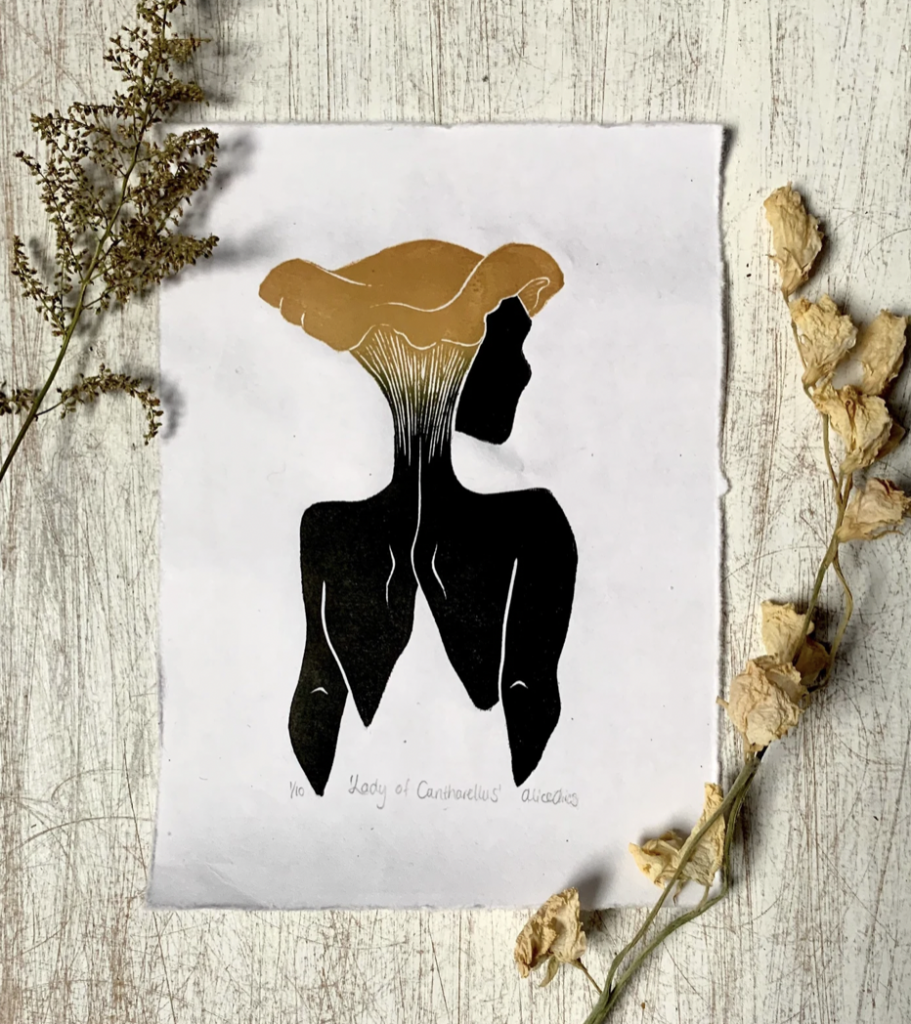
Lady of Cantharellus, original linocut print by Alice Aries Artworks
They tend to hold court in the same locations year after year, with a particular liking for damp mossy banks beneath beech and wet mossy grass under birch. They also can do well under scots pine and (less often) oak. They do particularly well in wet sitka spruce plantations, especially in the Scottish highlands.
While their flavour perhaps isn’t quite as good as that of ceps, they more than make up for it in looks and texture. And if you are picking your own, there is something wonderfully sensual about easing them from their mossy beds in the dancing shadows of beech and birch trees.
Their other great advantage over most other types of wild mushroom is that they are not susceptible to maggot infestation and will happily lounge in damp moss and grass for several weeks without deteriorating. They also enjoy a long growing season, especially on the west coast of Scotland, where I have picked fully grown specimens as early as May and as late as January.
For responsible foragers, determining exactly what is a fully grown chanterelle that has had plenty of time to spread its spores can be a tricky judgement. I generally advocate not picking any with a cap diameter less than 2cm. Some, especially those growing directly out of firm moss may never reach 2cm, especially if they get hit by a dry spell mid-growth, but I think its best to give them a chance. More on this here.
Chanterelles are robust and persistent in habitats they like. I’ve been harvesting from some of my spots every year for 30 years now. They have better years and worse years but all the evidence suggests that harvesting has little or no impact on the mycelium that gives life to them. Having said that, constant heavy cropping of immature mushrooms is pretty inconsiderate behaviour. I urge anyone picking any wild mushroom to exercise restraint (I know it can be hard) until they really get to know their patches. Please read my guidelines for responsible picking.
How to tell a Chanterelle from a False Chanterelle
You would think that such charming and striking little mushrooms would be easy enough to identify without fear of mistakes. For the most part they are, but fungi never quite give themselves up that easily. You should be aware of the false chanterelle (Hygrophoropsis aurantiaca) which can easily be mistaken for true chanterelles if you are not used to the feel, or gestalt, of the true mushroom. This is not a life-threatening mistake should you make it, as the imposter is edible, though not nearly so good and may cause mild hallucinations for some people. I have never been this lucky.
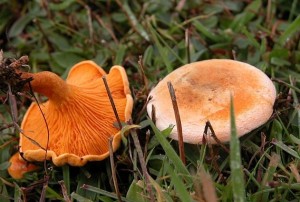
The false chanterelle (Hygrophoropsis aurantiaca) has true (though shallow) gills which are decurrent (run down the stem) but tend to end more abruptly than true chants. The cap is finely downy and often rolled in at the margin. It is generally more rounded in shape and flimsier. Found only beneath conifers.
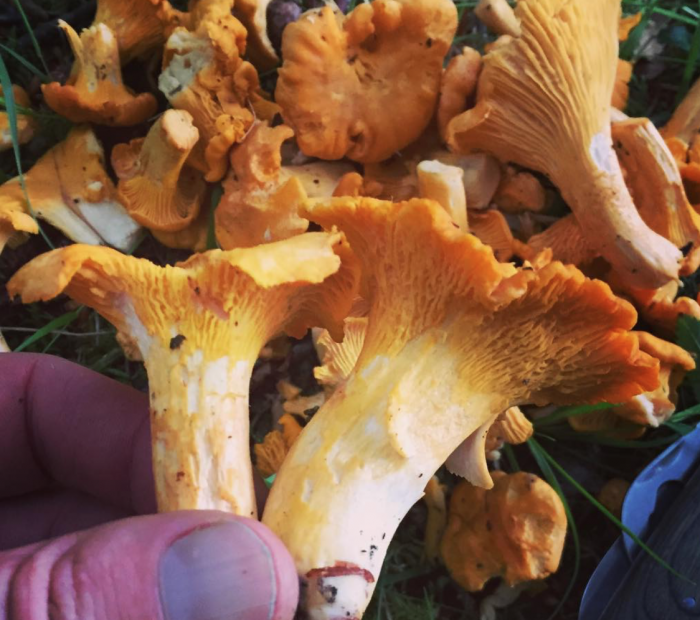
True chanterelle (Cantharellus cibarius): Note their stocky build, even when immature. Gills like “combed plastercine”. Usually with a highly irregular margin when mature. Some report a smell of apricots, and they can definitely smell “fruity”, but sometimes you’ll need a whole basket load for this to become noticeable.
How To Cook Chanterelles
Chanterelles are a true gastronome’s mushroom. They are regularly paired with eggs, and while I suspect a little colour sympathy here, they really are delicious in good, snotty scrambled eggs (made with double cream, and perhaps a trickle of truffle oil). I go a step further and put them, after cooking, in tarts or my famous “mile-high wild pie” with other foraged goodies like sea beet or orache. A sprinkle of wood sorrel (from which the mushrooms were probably picked) on a finished dish sets it off a treat.
Don’t make the all-too-common mistake of undercooking chanterelles. In this age of al-dente vegetables, people tend to forget that some foods benefit from longer cooking. Chanterelles, like all fungi, have a high water content which needs to be driven off to intensify their flavour and firm up their texture. Fungi don’t break down with cooking in the same way as vegetables tend to due to their cell walls being composed of compound called chitin.
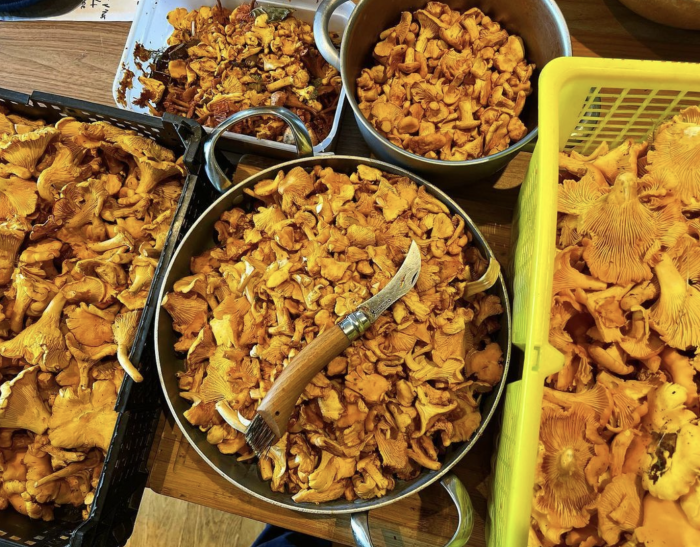
Grading the chanterelle harvest
Chanterelles don’t dry well, so my grading/preservation strategy is:
Grade 1: Tight firm buttons – for pickling or cooking fresh in sauces
Grade 2: Big but still firm – cook/freeze for use in tarts, pies etc
Grade 3: Getting flubbery – cook for soup/paté/freezing/boozy infusions. Strain & reduce the stock that comes out of them & freeze in large ice cube trays
Trimmings: Strew judiciously in likely habitats (far from a dead-cert, but can’t do any harm!), or infuse into vodka to make chanterelle schnapps.
My preferred method of cooking chanterelles is to start them in a frying pan over a high heat with a lid on and a knob of butter for a few minutes. They will exude a lot of moisture. Strain this nectar off, season & enjoy. As good as soup gets for me, and possibly my favourite chanterelle ‘recipe’ – if you can call it that!
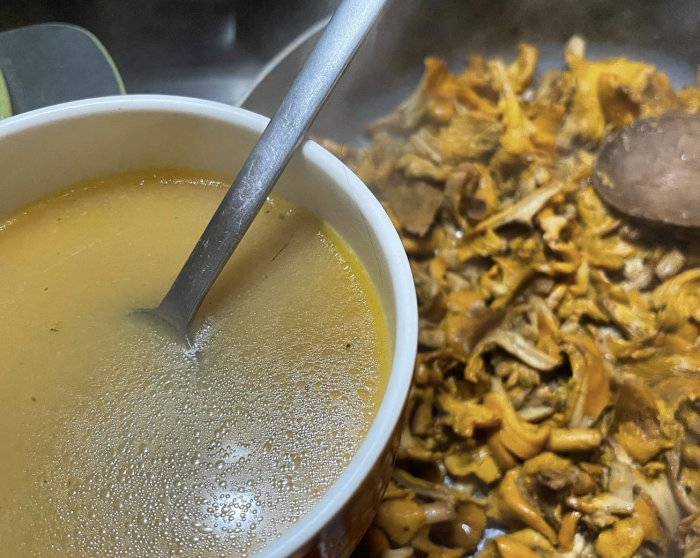
Pure chanterelle broth, every drop of which has been exuded from a chanterelle!
In the unlikely event that you don’t eat all that golden broth immediately, reduce & freeze in ice cube trays – it makes brilliant stock for sauces.
With all that juice removed you can add a little oil and/or more butter to the mushrooms and get on with frying & colouring them up. I like to sear them until they have a hint of caramelisation.
Another one-pan way to take advantage of this juice-exuding tendency is to stir in some dehydrated mushroom powder, and/or seaweed powder to thicken the juices. Then crack some eggs into the pan, over the mushrooms, and put a lid over them and turn the heat down. The eggs will poach and steam in the mushroom juices. This is best eaten straight from the pan so the yolks break and trickle through the mushrooms. I serve “Forager’s Eggs” like this on private fungi forays where there are just close friends and family in attendance!
Related Posts:
- Sustainable and Considerate Chanterelle Harvesting
- How to pickle chanterelles (and other wild mushrooms)
- Pickled chanterelles with pineapple weed recipe
- An Introduction to Fungi Foraging
- Winter Chanterelles
- Wild Fungi Guide
- Wild Mushroom Recipes
- Guided Foraging Walks
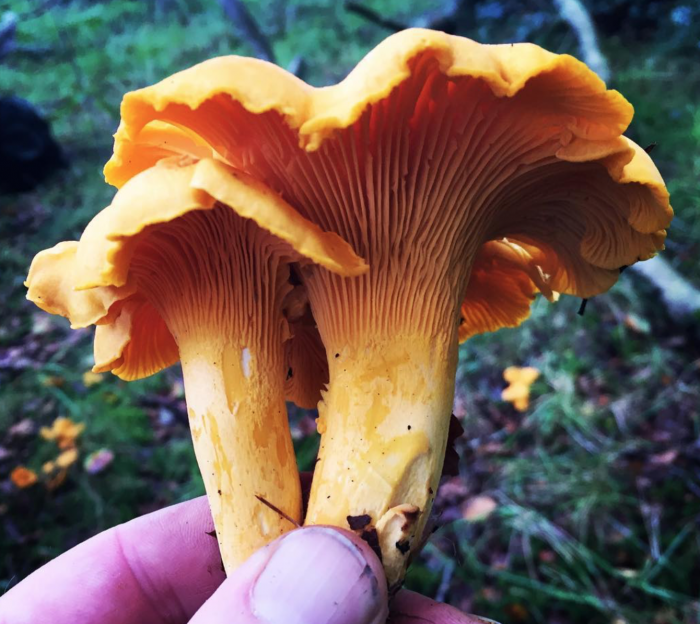

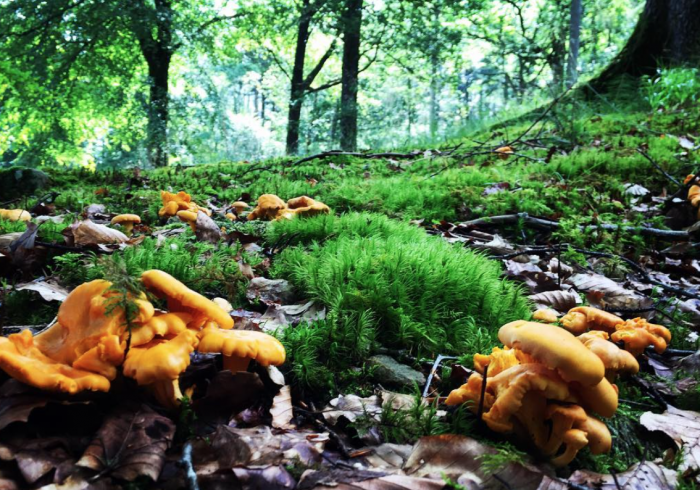
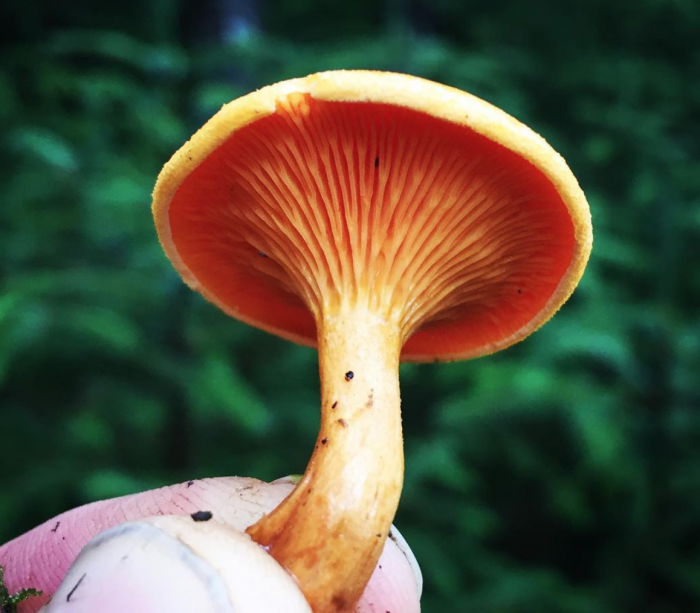

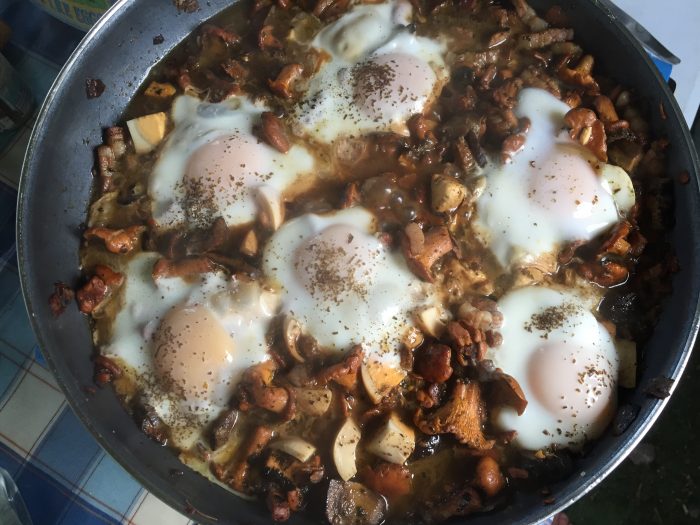
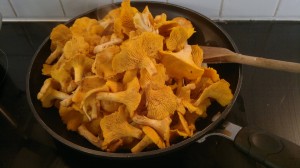
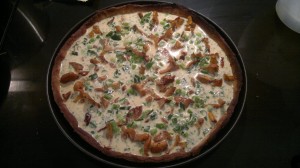
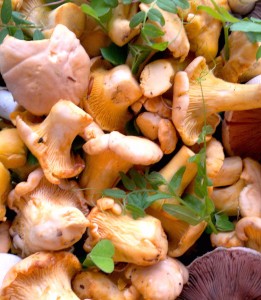
11 Comments
Might be worth adding that the chanterelle can sometimes be confused with omphalotus olearius, also known as the “jack-o-lantern” mushroom, which is poisonous. It occurs usually beneath oak and has been spotted on the British Isles, although only catalogued in the south-east. Very unlikely to be found in Scotland, but possible.
Just to add that jack-o-lantern grows on wood, not on soil.
However, if growing on wood under the ground, like roots or buried branches/stumps it can appear to be growing out of the ground. Also, the gills are bioluminescent…
Chanterelles grow in abundance on our homestead the easiest way to distinguish them from Jack-o-lantern is actually quite simple. The inside of the Chanterelles stem is white and resembles string cheese on the other hand the Jack-o-lantern stem on the inside is as orange as the outside also Jack-o-lanterns have true gills, Chanterelles have false gills
If I scattered chanterelle spores last July ( assuming the slurry I made was successful ), will they be visible one year later or does it take 2 years for them to develop ?
Thanks, Jan
Hi Jan, there are too many variables to make a helpful prediction…but you will find some useful in depth insight on the growth habits of chanterelles here Best wishes, Mark
I’ve been spreading in my local area for 10 years now and all I can say is who knows?
One beautiful, mossy, small birch and old oak wood with a little bracken stubbornly refuses to produce anything at all.
Other spots have produced after 3 years.
Jan, I recently saw a post (in Norway) which suggests an 8-year wait period!! 2 forum members reported, independently, that they got a crop after 8 years spreading in their gardens (similar habitats to where they were found). Requires patience, to say the least! Good luck
You have not mentioned using chanterelles to make duxelles! This is a paste or pâté made with mushroom and onion (and whatever you like) cooked down with butter- never oil- then mashed in a blender or food processor…..can be further baked like a pâté. This is a most divine use for stems when your family us spoiled to a great abundance of perfect “heads”!!!!
This is a really useful page – thank you! I go to Finland every year to visit my husbands family and we have some chanterelle spots there that we forage, but I’m really keen to find some spots in the UK (Bucks) that I can forage, so there’s some great tips about habitat here to get me started, as it’s different in Finland!
I just found this page after harvesting a crop of large chanterelles from under a very large spruce tree not far from our house. We live in Humboldt Co. California very near the ocean. My grandson found the original crop three years ago. And this is November! The land doesn’t belong to us but ivy has invaded the area and is preventing the heads from coming up without being deformed so I want to go over and pull out as much as I can to give the lovely chants free rein. Thanks for all the tips on cooking and keeping!